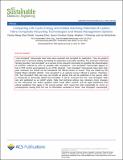Comparing Life Cycle Energy and Global Warming Potential of Carbon Fiber Composite Recycling Technologies and Waste Management Options
Author(s)
Meng, Fanran; Olivetti, Elsa A.; Zhao, Youyang; Chang, Jiyoun Christina; Pickering, Stephen J.; McKechnie, Jon; ... Show more Show less
DownloadAccepted version (803.4Kb)
Terms of use
Metadata
Show full item recordAbstract
Carbon fiber reinforced polymers (CFRP) are used in increasing quantities as they have some of the best properties in terms of specific strength and stiffness of any widely available material. By 2020, annual global CFRP production is expected to be over 140,000 tonnes. However, the resulting increased quantity of CFRP waste has highlighted the need for sustainable treatment options as carbon fiber manufacture has high-energy intensity. A life cycle assessment methodology is used to evaluate primary energy demand (PED) and global warming potential (GWP) leveraging best available literature data, process models, and experimental work. Overall results indicate that recycling scenarios are generally the environmentally preferable options over landfill and incineration. However, the relative environmental benefits of advanced recycling processes (i.e., pyrolysis, fluidized bed, and chemical recycling process) depend on the method used to determine displacement of virgin carbon fiber by recycled carbon fiber. Totally, recycling processes can achieve a representative GWP from -19 to -27 kg CO2eq and PED from -395 to -520 MJ per kg CFRP, providing superior environmental performance to conventional composite waste treatment technologies.
Date issued
2018-06Department
Massachusetts Institute of Technology. Department of Materials Science and Engineering; Massachusetts Institute of Technology. Institute for Data, Systems, and SocietyJournal
ACS Sustainable Chemistry & Engineering
Publisher
American Chemical Society (ACS)
Citation
Meng, Fanran et al. "Comparing Life Cycle Energy and Global Warming Potential of Carbon Fiber Composite Recycling Technologies and Waste Management Options." ACS Sustainable Chemistry & Engineering 6, 8 (June 2018): 9854–9865 © 2018 American Chemical Society
Version: Author's final manuscript
ISSN
2168-0485